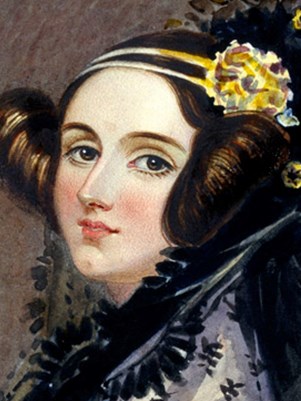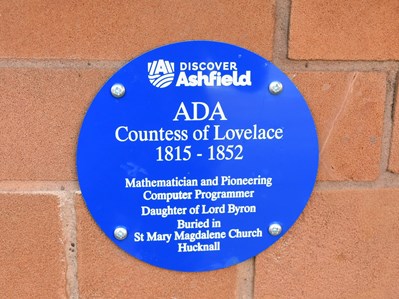Ada Lovelace
It’s not often you leave such a profound legacy to have a computer language named in your honour, have your illustration in British passports, and become the subject of a Google Doodle on International Women’s Day. Ada Lovelace certainly lived up to these tributes, and was considered the world’s first computer programmer. It’s undoubtedly difficult carving your own path when following in the footsteps of a famous parent, but Ada was definitely successful. The daughter of prominent Romantic poet Lord Byron, Ada showed her gift for mathematics at an early age and worked with inventor Charles Babbage on the mechanical computer called the Analytical Engine.
Early years
Ada Lovelace, born as Augusta Ada Byron in London on 10 December 1815, was the only legitimate child of the Romantic poet, Lord Byron. Lord Byron's marriage to Ada's mother, Lady Anne Isabella Milbanke Byron, was not a happy one.
 Pictured: Ada Lovelace and Lord Byron. Lady Byron separated from her husband only weeks after their daughter was born. A few months later, Lord Byron left England and his ancestral home in Newstead Abbey, in Nottinghamshire, and Ada never saw her father again. He died in Greece when Ada was 8-years-old.
Pictured: Ada Lovelace and Lord Byron. Lady Byron separated from her husband only weeks after their daughter was born. A few months later, Lord Byron left England and his ancestral home in Newstead Abbey, in Nottinghamshire, and Ada never saw her father again. He died in Greece when Ada was 8-years-old.
Early years
Ada Lovelace, born as Augusta Ada Byron in London on 10 December 1815, was the only legitimate child of the Romantic poet, Lord Byron. Lord Byron's marriage to Ada's mother, Lady Anne Isabella Milbanke Byron, was not a happy one.
 Pictured: Ada Lovelace and Lord Byron. Lady Byron separated from her husband only weeks after their daughter was born. A few months later, Lord Byron left England and his ancestral home in Newstead Abbey, in Nottinghamshire, and Ada never saw her father again. He died in Greece when Ada was 8-years-old.
Pictured: Ada Lovelace and Lord Byron. Lady Byron separated from her husband only weeks after their daughter was born. A few months later, Lord Byron left England and his ancestral home in Newstead Abbey, in Nottinghamshire, and Ada never saw her father again. He died in Greece when Ada was 8-years-old.Talent for numbersAda had an unusual upbringing for an aristocratic girl raised in the mid-1800s. At her mother's insistence, tutors taught her mathematics and science. Such challenging subjects were not standard fare for girls at the time, but her mother believed that engaging in rigorous studies would prevent Ada from developing her father's moody and unpredictable temperament. Ada was also forced to lie still for extended periods of time, because her mother believed it would help her develop self-control. From early on, Ada showed a talent for numbers and language. She received instruction from William Friend, a social reformer; William King, the family's doctor; and Mary Somerville, a Scottish astronomer and mathematician. Somerville was one of the first women to be admitted into the Royal Astronomical Society.
Lovelace and Babbage
Around the age of 17, Ada met Charles Babbage, an English mathematician and inventor. The pair became friends, and the much older Babbage served as a mentor to Ada. Through Babbage, Ada began studying advanced mathematics with University of London professor, Augustus de Morgan. Ada was fascinated by Babbage's ideas. Known as the father of the computer, he invented the Difference Engine, which was meant to perform mathematical calculations. Ada got a chance to look at the machine before it was finished, and was captivated by it. Babbage also created plans for another device known as the Analytical Engine, designed to handle more complex calculations.
Babbage and the Analytical Engine
Ada was later asked to translate an article on Babbage's Analytical Engine, which had been written for a Swiss journal by Italian engineer Luigi Federico Menabrea. She not only translated the original French text into English, but also added her own thoughts and ideas on the machine. Her notes ended up being three times longer than the original article. Her work was published in 1843, in an English science journal. Ada used the initials 'A.A.L.' for Augusta Ada Lovelace in the publication. In her notes, Ada described how codes could be created for the device to handle letters and symbols along with numbers. She also theorised a method for the engine to repeat a series of instructions, a process known as looping, which computer programs use today. Ada also offered up other forward-thinking concepts in the article. Due to this work, Ada is often considered to be the first ever computer programmer.
Personal life
 Ada's article on the Analytical Engine attracted little attention when she was alive. In later years she tried to develop mathematical schemes for winning at gambling, but unfortunately her schemes failed putting her in financial peril. In 1835, Ada married William King who became the Earl of Lovelace three years later. She then took the title of Countess of Lovelace. They shared a passion for horses and had three children together. From most accounts, William supported his wife's academic endeavours. Ada and her husband socialised with many of the interesting minds of the time, including scientist Michael Faraday and writer Charles Dickens.
Ada's article on the Analytical Engine attracted little attention when she was alive. In later years she tried to develop mathematical schemes for winning at gambling, but unfortunately her schemes failed putting her in financial peril. In 1835, Ada married William King who became the Earl of Lovelace three years later. She then took the title of Countess of Lovelace. They shared a passion for horses and had three children together. From most accounts, William supported his wife's academic endeavours. Ada and her husband socialised with many of the interesting minds of the time, including scientist Michael Faraday and writer Charles Dickens. Ada's health suffered after a bout of cholera in 1837. She had lingering problems with asthma and her digestive system. Doctors gave her painkillers, such as laudanum and opium, and her personality began to change. She reportedly experienced mood swings and hallucinations. Ada died from uterine cancer in London on 27 November 1852. She was buried next to her father, in the graveyard of the Church of St Mary Magdalene, in Hucknall, Nottinghamshire.
Ada's legacy
Ada Lovelace's contributions to the field of computer science were not discovered until the 1950s. Her notes were reintroduced to the world by English scientist B.V. Bowden, who republished them in Faster Than Thought: A Symposium on Digital Computing Machines in 1953. Since then, Ada has received many posthumous honours for her incredible work. In 1980, the U.S. Department of Defence named a newly developed computer language after Lovelace called Ada.
 Ada Lovelace Day is annually held on the second Tuesday of October and was created to raise awareness of the contributions that women have made to the STEM fields of science, technology, engineering, and mathematics.
Ada Lovelace Day is annually held on the second Tuesday of October and was created to raise awareness of the contributions that women have made to the STEM fields of science, technology, engineering, and mathematics. In 2015, Ada along with Charles Babbage featured as an illustration on all new British passports, and in 2017 Ada was honoured among a group of women on International Women's Day as a Google Doodle.
Places to visit
Visit the historic St Mary Magdalene Church in Hucknall to discover the Byron family vault that includes Ada and her father Lord Byron. Learn more about Ada at her father Lord Byron's old home Newstead Abbey in Ravenshead, Nottinghamshire.